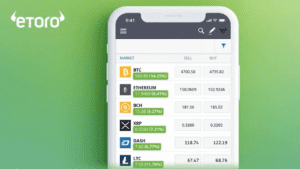In an age where digitalization is sweeping across various industries, the world of financial planning is no exception. From online banking to blockchain, the financial services sector is undergoing a significant transformation. One of the most exciting developments in this digital age is the emergence of robo-advisors—automated platforms that offer financial advice or investment management online, with moderate to minimal human intervention.
Robo-advisors have taken Europe by storm, democratizing access to investment strategies and financial planning that were once the exclusive domain of the wealthy or the financially savvy. Whether you are a casual investor looking to dip your toes into the investment pool, or a seasoned asset manager seeking cost-efficient diversification, understanding the capabilities and limitations of robo-advisors is crucial.
In this comprehensive guide, we will delve into the intricate world of robo-advisors in Europe, exploring their evolution, advantages, risks, and how they fit into the broader landscape of digital wealth management. We aim to provide you with a meticulous analysis that leaves no stone unturned, helping you make informed decisions in this ever-evolving financial landscape.
What Are Robo-Advisors?
Definition and Function
Robo-advisors are automated financial platforms that use algorithms to provide investment advice and manage your portfolio. They are designed to optimize asset allocation based on your financial goals, risk tolerance, and investment horizon, all without the necessity of human intervention at every stage. In essence, these platforms serve as a digital interface that can execute a wide range of tasks—from rebalancing your portfolio to tax-loss harvesting, and much more.
Join the world's biggest trading network & get instant access to a personal account manager!
Brief History and Evolution
The concept of robo-advisors isn’t entirely new; automated systems have been aiding investment managers and advisors in various capacities for years. However, the modern iteration of robo-advisors, characterized by direct-to-consumer platforms, started gaining prominence after the 2008 financial crisis. Technology and consumer expectations coalesced to demand more transparent, cost-effective, and accessible financial services. In Europe, the rise of fintech companies has further accelerated the adoption of robo-advisors, creating a vibrant ecosystem that continuously evolves to include more features and cater to a diverse set of investment needs.
How They Differ from Traditional Financial Advisors
The primary difference between robo-advisors and traditional financial advisors lies in the level of human interaction and the cost structure.
- Human Interaction: Traditional advisors typically offer customized advice based on in-depth conversations and ongoing relationships. Robo-advisors, on the other hand, primarily rely on algorithms to assess your investment needs based on a questionnaire you fill out online.
- Cost: Traditional advisors often charge a percentage of the assets under management (AUM) and may have additional fees, making them more expensive. Robo-advisors usually have a lower fee structure, sometimes charging a flat monthly fee or a smaller percentage of AUM.
- Accessibility: Robo-advisors are accessible 24/7 and usually require lower minimum investments, democratizing access to financial planning.
Types of Robo-Advisors
Algorithm-based
These are the “pure-play” robo-advisors that rely solely on algorithms for portfolio management. They are the most cost-effective option but offer little to no human interaction. These platforms are best suited for investors who are comfortable with a hands-off approach and are mainly looking for portfolio management.
Hybrid Models
Hybrid robo-advisors combine algorithmic portfolio management with access to human advisors for more complex financial planning needs. This model offers a balanced approach, allowing for automated efficiency while still providing the option for human interaction. Typically, they cost slightly more than algorithm-based robo-advisors but less than traditional advisors.
Niche Advisors for Specific Investment Strategies
Some robo-advisors focus on specific niches like sustainable investing, cryptocurrencies, or particular geographic regions. These platforms are tailored for investors who have specialized investment needs or goals and are willing to trade off a bit of cost-efficiency for a portfolio that aligns closely with their values or interests.
Understanding the nuances between these types can significantly impact your experience and success with robo-advisors, making it crucial to choose the right model based on your investment goals, need for human interaction, and cost considerations.
The European Landscape
The rise of robo-advisors has left a significant footprint on the European investment landscape. With a growing appetite for financial technology and an increasingly favorable regulatory environment, Europe is seeing an uptick in the adoption of these digital platforms. In this section, we will delve into the market size, regulatory frameworks, leading players, and country-specific trends that define the European robo-advisory ecosystem.
Market Size and Growth
The European robo-advisory market has experienced robust growth over the past few years. According to estimates, the total assets under management (AUM) by robo-advisors in Europe exceeded €10 billion as of the end of 2022. This figure is expected to grow at a Compound Annual Growth Rate (CAGR) of approximately 20-25% over the next five years. The growth can be attributed to a variety of factors, including increased consumer confidence in digital financial services, technological advancements, and lower entry barriers for retail investors.
Regulatory Environment
Regulation is a critical aspect of any financial market, and the robo-advisory sector is no exception. In Europe, these platforms are usually regulated as investment firms under the Markets in Financial Instruments Directive II (MiFID II). This directive ensures that robo-advisors maintain a level of transparency, due diligence, and consumer protection. Regulatory compliance is pivotal, both for ensuring the safety of client funds and for fostering a conducive environment for the growth of digital wealth management services.
Leading Robo-Advisors in Europe
There are several key players in the European robo-advisory space, each with its unique value proposition:
- Nutmeg: Known for its user-friendly interface and low-cost portfolios, Nutmeg is a leading robo-advisor in the UK.
- Scalable Capital: With a strong presence in Germany and the UK, Scalable Capital offers risk-managed portfolios and a hybrid advice model.
- ETFmatic: Serving clients across several European countries, ETFmatic specializes in creating portfolios made entirely of ETFs.
- Yomoni: Based in France, Yomoni offers a blend of algorithmic and human advisory services, focusing on long-term investments.
- Moneyfarm: Originating from Italy and expanding to the UK, Moneyfarm offers a variety of portfolios tailored to different risk levels.
Country-specific Insights
Germany
Germany’s robo-advisory market is characterized by a high level of technological adoption and a strong regulatory framework. Firms like Scalable Capital and Ebase are gaining traction by offering advanced algorithmic strategies and hybrid advisory models.
UK
The UK is often seen as the birthplace of robo-advisory services in Europe, with firms like Nutmeg and Moneyfarm paving the way. British investors are increasingly embracing these platforms for their low costs, ease of use, and transparent fee structures.
France
In France, robo-advisors like Yomoni and WeSave are capturing the market by offering comprehensive financial planning services in addition to basic portfolio management. The focus here is not just on asset allocation but also on broader financial well-being.
Others
Countries like the Netherlands, Switzerland, and Spain are also witnessing the gradual rise of robo-advisors, albeit at a slower pace compared to Germany, the UK, and France. Firms in these countries often collaborate with traditional financial institutions to offer a broader range of services.
Understanding these regional nuances can guide investors in selecting the most appropriate robo-advisory platform, thereby optimizing the potential for investment success.
Advantages of Using Robo-Advisors
Robo-advisors have significantly democratized the landscape of financial planning and investment management. However, the buzz around these platforms is not merely hype; there are tangible benefits that make robo-advisors a compelling option for investors. In this section, we’ll explore some of the most compelling advantages of using robo-advisors, including their cost-effectiveness, accessibility, diversification capabilities, and tax-efficiency.
Cost-effectiveness
One of the most salient advantages of robo-advisors is their cost structure. Traditional financial advisors typically charge between 1% to 2% of the assets under management (AUM), along with potential transaction and other hidden fees. In contrast, robo-advisors usually charge a flat monthly fee or a lower percentage of AUM, often ranging from 0.25% to 0.50%. This pricing model translates into considerable savings over time, especially for investors with smaller portfolios who still seek professional asset management.
Accessibility
Robo-advisors are designed to be incredibly user-friendly, requiring no specialized financial knowledge to get started. They are accessible around the clock, providing the convenience of setting up and managing your portfolio anytime, anywhere. Moreover, robo-advisors often have low minimum investment requirements, making it easier for novice investors to enter the market.
Diversification
Robo-advisors use algorithms that consider various asset classes and employ strategies such as Modern Portfolio Theory to create diversified portfolios. The automated nature of these platforms allows them to rebalance your portfolio to align with your risk profile continuously. This level of diversification is often difficult to achieve for individual investors who do not have the time or expertise to manage multiple asset classes.
Tax-Efficiency
Many robo-advisors offer tax-efficient investing strategies, such as tax-loss harvesting, that can help you maximize your after-tax returns. These strategies involve systematically selling off losing investments to offset the taxes on gains, thereby enhancing your overall portfolio performance. While tax-loss harvesting is not unique to robo-advisors, the automation makes it a more accessible tool for the average investor.
Case Studies: Real-world Examples of Success Stories
Case Study 1: The Millennial Investor
Sophia, a 28-year-old graphic designer, started investing through a robo-advisor with just €2,000. Within two years, she had an average annual return of 7%, significantly higher than what she would have earned through a traditional savings account. The low fees and automatic rebalancing enabled her to grow her investment efficiently.
Case Study 2: The Busy Professional
John, a 40-year-old lawyer with no time to manage his investments, switched from a traditional advisor to a robo-advisor. Not only did he cut his annual fees by half, but he also benefitted from automated tax-loss harvesting, increasing his after-tax returns.
Case Study 3: The Sustainable Investor
Emily is passionate about environmental causes and wanted her investments to reflect her values. She opted for a niche robo-advisor specializing in sustainable investing. Through this platform, Emily was able to invest in a diversified portfolio of ESG-compliant assets, achieving both ethical alignment and financial growth.
These real-world examples underscore the varied advantages of using robo-advisors, irrespective of your financial goals or expertise. Whether it’s reducing costs, making investing more accessible, or optimizing for tax-efficiency, robo-advisors offer a compelling suite of benefits that traditional investment channels often can’t match.
Risks and Considerations
While robo-advisors offer an array of advantages, like any financial tool, they are not without risks and limitations. Understanding these potential pitfalls is crucial for making an informed decision about whether a robo-advisor is right for your investment strategy. Below we explore some of the inherent challenges associated with these platforms, such as the limitations of algorithms, market risks, and regulatory hurdles.
Limitations of Algorithms
Robo-advisors rely heavily on algorithms to make investment decisions. While these algorithms are generally based on proven financial theories, they can’t account for all possible market conditions or the intricacies of individual financial situations. For example, an algorithm might not adjust quickly enough to sudden geopolitical events or market anomalies.
Market Risks
Market risks are inherent to any form of investing, whether manual or automated. While robo-advisors aim to optimize returns and mitigate risks through diversification, they cannot completely eliminate the possibility of market downturns affecting your investments.
Regulatory Challenges
Though robo-advisors in Europe generally operate under the stringent framework of MiFID II, the regulatory landscape is still evolving. Inconsistencies across countries and potential changes in regulation could impact the functioning and reliability of robo-advisory platforms.
How to Mitigate Risks
Recognizing the risks is the first step towards mitigation. Here are some actionable strategies that you can employ to minimize the risks associated with using a robo-advisor.
Diversification
While most robo-advisors inherently offer diversified portfolios, it’s wise to diversify across different types of investment vehicles and perhaps even use multiple robo-advisors or a combination of robo-advisors and traditional investment platforms. This strategy can help you spread risk and capitalize on the unique advantages of each platform.
Regular Reviews
Automated doesn’t mean “set and forget.” Regularly reviewing your portfolio’s performance can help you understand how your investments are faring and whether they align with your financial goals. Many robo-advisors offer tools and analytics to help you perform this analysis effortlessly.
Consulting a Human Advisor
Consider using a hybrid robo-advisor that combines algorithmic trading with human expertise, or keep a human financial advisor for more complex financial planning needs. Humans can offer nuanced advice that algorithms currently cannot, such as estate planning, retirement planning involving multiple income streams, and strategies for tax optimization beyond straightforward tax-loss harvesting.
By proactively managing these potential risks and limitations, you can better safeguard your investments and make the most of the advantages that robo-advisors offer. This balanced approach allows you to enjoy the benefits of automation without completely surrendering the reins, thereby providing a holistic and robust investment strategy.
How to Choose a Robo-Advisor
Selecting the right robo-advisor is a crucial step in your investment journey. With numerous options on the market, each with its unique features and value propositions, making an informed choice can be daunting. Here, we delve into the essential factors you should consider when choosing a robo-advisor, including fees, asset classes, user experience, and customer service.
Factors to Consider
Fees
Cost is a pivotal factor when it comes to investing. Make sure you understand not just the advisory fees but also any underlying costs associated with the investments themselves, like expense ratios for ETFs or mutual funds. Lower fees can substantially improve your returns over time.
Asset Classes
What types of assets does the robo-advisor invest in? Some robo-advisors focus solely on stock and bond ETFs, while others may offer more exotic assets like cryptocurrencies or commodities. Choose a robo-advisor that aligns with your desired level of diversification and risk tolerance.
User Experience
A well-designed, intuitive interface can make the investing process more enjoyable and efficient. Consider the usability of the platform, especially if you plan to engage with it frequently. Many robo-advisors offer demo accounts or virtual tours—take advantage of these to assess the platform’s user-friendliness.
Customer Service
Even with automated platforms, excellent customer service is invaluable. Whether it’s a technical glitch or a question about your portfolio, you want to know that help is available when needed. Look for platforms with multiple channels for support, such as chat, email, and phone, and consider the speed and quality of their responses.
Comparison of Top European Robo-Advisors
To help you navigate the landscape of European robo-advisors, here’s a brief comparison focusing on performance, costs, and user reviews:
Performance
- Nutmeg: Consistently shows good returns, particularly for higher-risk portfolios.
- Scalable Capital: Known for its risk management, the platform usually provides steady performance.
- ETFmatic: Focuses on low-cost ETFs, which usually offer reliable performance over the long term.
- Yomoni: This French-based robo-advisor has shown strong performance, particularly in its diversified portfolios.
Costs
- Nutmeg: Charges between 0.45% and 0.75% based on the account type and size.
- Scalable Capital: Fees are at a competitive 0.75% for fully managed portfolios.
- ETFmatic: Known for its low-cost structure, fees range from 0.48% to 0.60%.
- Yomoni: Charges a flat fee of 1.6%, which includes all trading and transaction costs.
User Reviews
- Nutmeg: Highly rated for its user interface and ease of use, but some users mention the fee structure as a downside.
- Scalable Capital: Reviews often highlight the platform’s robust risk-management features and quality customer service.
- ETFmatic: Users appreciate the platform’s simplicity and low fees but would like to see more features.
- Yomoni: French users commend the platform’s customer service and range of financial planning services.
By carefully evaluating these factors and making direct comparisons, you can better identify which robo-advisor aligns most closely with your investment goals and preferences. Remember, choosing a robo-advisor is not a one-size-fits-all decision. Your personal financial situation, investment goals, and risk tolerance should guide you in making the most suitable choice.
Conclusion
As we’ve seen, robo-advisors have dramatically changed the landscape of investing and wealth management, not just globally but also specifically in Europe. These platforms offer numerous advantages, such as cost-effectiveness, accessibility, diversification, and tax-efficiency. However, they are not without their limitations and risks, which include algorithmic constraints, market vulnerabilities, and regulatory uncertainties. To make an informed choice, potential users should weigh the fees, asset classes, user experience, and customer service that each platform offers.
Summary of Key Takeaways
- Robo-advisors offer a cost-effective and accessible way to start investing or to manage existing portfolios.
- Algorithms power these platforms, making them efficient but also somewhat limited in their ability to navigate complex market dynamics.
- Regulatory frameworks, like MiFID II in Europe, provide a level of safety but are still evolving.
- Risk mitigation is possible through diversification, regular portfolio reviews, and, if necessary, consultation with a human advisor.
The Future Outlook of Digital Wealth Management in Europe
As financial technologies continue to evolve, digital wealth management is poised for further growth in Europe. The convergence of Big Data, machine learning, and increasingly sophisticated algorithms will likely make robo-advisors even more precise and customizable. At the same time, regulatory bodies will continue to adapt, ensuring that these platforms meet robust safety and transparency standards.
We can also expect to see more specialized robo-advisors entering the market, targeting niche investment strategies and demographic segments. As a result, the wealth management space will become even more democratized, offering a broader range of investment solutions to a more diverse set of investors.
Recommended Resources
For those interested in diving deeper into the subject, the following resources can offer further insights:
Books
- “The Intelligent Asset Allocator” by William J. Bernstein: A comprehensive guide on how to build a diversified portfolio.
- “Digital Wealth: An Automatic Way to Invest Successfully” by Simon Bussy: Focuses on the rise of robo-advisors and the future of digital wealth management.
Websites
- Investopedia: A comprehensive source for all things investing, including detailed articles on robo-advisors.
- Morningstar: Offers professional reviews and analysis of various investment platforms, including robo-advisors.
Courses
- “Introduction to Robo-Advisors” on Udemy: A beginner-friendly course covering the basics of what robo-advisors are and how they function.
- “Financial Markets and Investment Strategy Specialization” on Coursera: Offers more advanced knowledge about financial markets, including algorithm-based investment strategies.
Armed with this knowledge and these resources, you are better prepared to navigate the evolving landscape of digital wealth management in Europe. The key is to continually educate yourself and to stay adaptive, making informed decisions that align with your financial goals and risk tolerance.

















